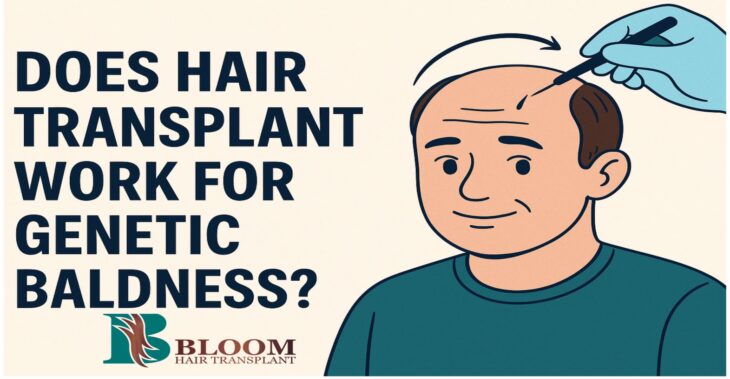
Does Hair Transplant Work for Genetic Baldness
Balding is something many of us dread. Whether it’s a receding hairline or thinning at the crown, the thought of losing hair can impact confidence and self-esteem. But for those dealing with genetic baldness, the question often arises – can a hair transplant cure baldness? Let’s break it down and see how modern hair transplant techniques can help.
Understanding Genetic Baldness
Genetic baldness, also known as androgenetic alopecia, is the most common cause of hair loss in men and women. For men, it often appears as a receding hairline or thinning at the crown, while women experience overall thinning. This type of hair loss is inherited and caused by the hormone dihydrotestosterone (DHT), which shrinks hair follicles over time.
But here’s the key point: while we can’t change our genes, we can restore hair in areas affected by baldness. That’s where hair transplants come in.
Can Hair Transplant Cure Baldness?
A hair transplant doesn’t “cure” baldness in the medical sense because it doesn’t stop the genetic process. However, it’s one of the most effective ways to restore hair permanently in bald areas.
In a hair transplant, healthy hair follicles are taken from the back or sides of your scalp (areas resistant to DHT) and transplanted to the thinning or bald spots. Since these transplanted hairs are not affected by genetic baldness, they continue to grow naturally for a lifetime.
So yes, a hair transplant works for genetic baldness, but only in the areas where hair follicles are implanted.
Why Choose a Hair Transplant for Genetic Hair Loss?
When it comes to addressing genetic hair loss, many treatments promise results, but few deliver a long-term solution. A hair transplant stands out as the gold standard for several reasons:
When it comes to addressing genetic hair loss, many treatments promise results, but few deliver a long-term solution. A hair transplant stands out as the gold standard for several reasons:
Permanent, Long-Lasting Results
Unlike temporary fixes such as wigs, hair fibres, or topical sprays that only mask the problem, a hair transplant offers a permanent solution. The procedure uses your healthy hair follicles (typically taken from the back or sides of your scalp, where hair is genetically resistant to balding) and transplants them to thinning or bald areas. These transplanted hairs continue to grow naturally for a lifetime because they retain their original genetic resistance to hair loss.
A Natural and Undetectable Look
Today’s advanced techniques like Follicular Unit Extraction (FUE) and Direct Hair Implantation (DHI) allow surgeons to recreate a hairline that blends seamlessly with your existing hair. Each graft is placed with precision, considering the natural direction, density, and pattern of your hair growth. This means your results don’t just look good – they look real. Even close friends and family often can’t tell the difference.
Minimal Maintenance for Maximum Confidence
Once your transplanted hair has fully grown in, it behaves just like your natural hair. You can wash, cut, colour, and style it however you like – no special shampoos, treatments, or daily routines required. There is no ongoing expense for maintenance, making it a cost-effective choice in the long run.
Boosts Confidence and Self-Esteem
For many people, genetic hair loss can take a toll on confidence and self-image. A successful hair transplant doesn’t just restore your hairline – it restores the way you feel about yourself. You can step out without worrying about thinning patches or receding hairlines, knowing your hair looks full and healthy again.
Safe and Proven with Minimal Downtime
Modern hair transplant techniques are minimally invasive, safe, and require little downtime. Most people can return to work within a few days and start seeing visible growth in as little as three to four months, with full results typically visible in nine to twelve months.
What to Expect After a Hair Transplant
After the procedure, transplanted hair may initially shed (a normal process called “shock loss”), but new growth typically starts in 3-4 months. Within 9-12 months, you’ll notice a fuller head of hair.
It’s essential to note that while transplanted hairs are permanent, the surrounding existing hair may continue to thin. That’s why a good clinic will create a long-term plan for maintaining your overall hair health.
Does It Work for Everyone?
While hair transplants are highly effective, they aren’t suitable for everyone. Ideal candidates are –
- Have stable hair loss (usually over the age of 25)
- Have enough healthy donor hair
- Understand realistic expectations
If you’re unsure about your eligibility, a consultation with an experienced surgeon can help you decide the best approach.
Every Problem Has a Solution
If you’re struggling with hereditary hair loss and wondering, does hair transplant work for genetic baldness? – The answer is a confident yes for most people. While it doesn’t reverse the genetic process, it provides a permanent, natural-looking solution to restore your confidence. At Bloom Hair Transplant, we specialise in advanced techniques designed to give you the best possible results with minimal downtime.
Ready to reclaim your hair and confidence? Book a free consultation with our experts today!

